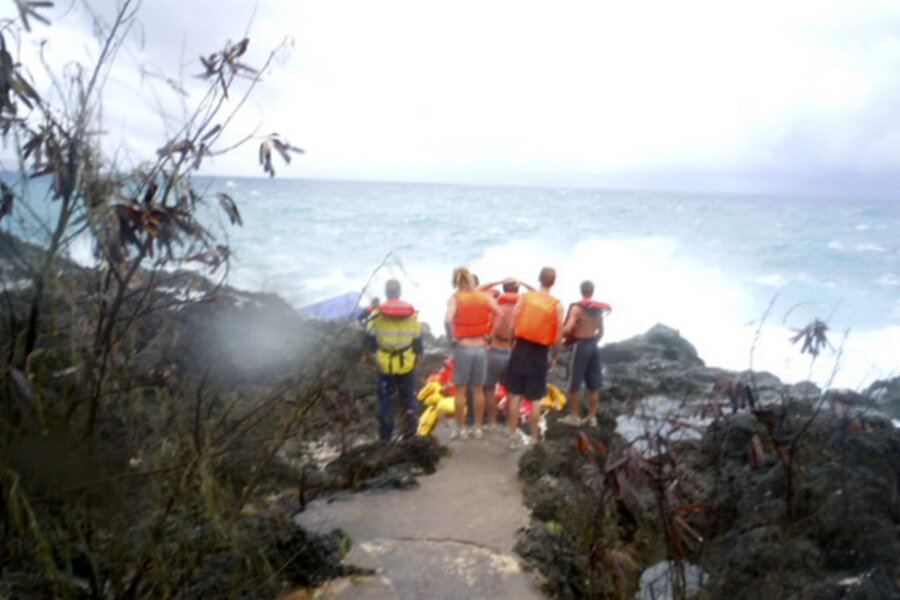Asylum seekers search continues in rough Australian waters
Loading...
| SYDNEY
Rescue personnel on a remote Australian island continued the search Friday for survivors or bodies from the horrific crash of a rickety wooden boat against a jagged cliff during a storm earlier this week that killed 30 migrants.
Navy and customs officers plucked 42 survivors — including nine children — from the raging surf off Christmas Island in the Indian Ocean soon after their boat broke apart and sank Wednesday.
Home Affairs Minister Brendan O'Connor said Friday that the bodies of a man and a boy aged about 11 had been found in the water by divers, raising the death toll to 30.
The boat, carrying up to 100 asylum seekers of Iraqi, Iranian and Kurdish origin, smashed into the jagged, limestone cliffs of Christmas Island, plunging the passengers into massive waves that battered them against the rocks. Twelve men, nine women and seven children — including four infants — were among the dead, the Customs and Border Protection Service said.
"We are not in a position at this point to determine whether there were other people on the vessel," O'Connor told Australian Broadcasting Corp. radio on Friday. "But our assumption is we need to continue this rescue."
Prime Minister Julia Gillard warned the death toll was likely to rise.
"We do not know with any certainty how many people there were on the boat, so we've got to prepare ourselves for the possibility that more bodies will be found and that there has been further loss of life than we know now," said Gillard, who promised a full investigation of the incident.
More than two dozen survivors were being cared for at a local hospital, and authorities transported two women with the worst injuries to Perth in mainland Australia for treatment. A victim identification team arrived Thursday, and trauma counselors, Red Cross workers and interpreters were on hand to help the 25 men, eight women and nine children who survived.
The Royal Flying Doctor Service sent doctors to the island to treat the injured, said spokeswoman Joeley Pettit-Scott. Blunt trauma was common among the victims, many of whom were battered by debris as they clung desperately to the remains of the sinking boat.
The tragedy highlighted the dangers hundreds of refugees face every year as they try to sail from Indonesia to Australia in cramped, barely seaworthy boats with few provisions and no safety gear. Most come from poor, war-ravaged countries such as Afghanistan and stop in Indonesia before setting off to start new lives in Australia.
Rescuers faced violent sea conditions Thursday, with a cyclone hovering nearby. Christmas Island is the 52-square-mile (135-square-kilometer) tip of a dormant volcano poking out of the Indian Ocean 1,600 miles (2,600 kilometers) from the Australian mainland.
"This is a very fluid situation and it's being conducted in what are quite difficult circumstances," Australian Federal Police Deputy Commissioner Andrew Colvin said.
Christmas Island residents watched helplessly from a cliff Wednesday as the boat struggled in the monstrous waves and then crashed, dumping screaming men, women and children into the stormy surf.
"It was just horrible. People getting crushed. Bodies, dead children, the whole thing was pretty awful," island resident Simon Prince told The Associated Press.
Christmas Island is closer to Indonesia than the Australian mainland and a frequent target of refugee hopefuls, who are housed in a detention center there.
Australian authorities acting on intelligence information usually track larger asylum seeker boats after they leave Indonesia and intercept them when they reach Australian waters. But smaller boats may not be spotted until they are very close to land.
The stricken boat appeared near the shore very early Wednesday morning in bad weather that hampered visibility. It took customs officials an hour and 13 minutes to reach the scene after they were first notified, according to a timeline released by the Customs and Border Protection Service.
Refugee advocates suggested Australian authorities should have known about the boat and done more to intercept it before it neared the rocky coast. But the prime minister praised the actions of the navy and customs officials who responded to the crisis, saying they risked their lives to save those in distress.
"In very rough and dangerous seas, there is a limit to what can be achieved in terms of radar and other surveillance mechanisms," Gillard said.
Asylum seekers have died in earlier journeys on the same route.
In October 2001, 374 people perished — most of them believed to be from Afghanistan and Iraq — when a boat sank en route from Indonesia to Christmas Island. Two years earlier, a boat believed to be carrying about 100 people disappeared and may have sunk.
"This incident is a tragic reminder of the danger faced by people fleeing persecution and human rights violations in their home countries, and the desperate measures they will resort to in search of safety," said Richard Towle, the U.N. refugee agency's regional representative.
According to the UNHCR, an estimated 848 people died or disappeared in 2009 in Italy, Yemen, Spain, and Greece — the main areas worldwide of large-scale migration.





